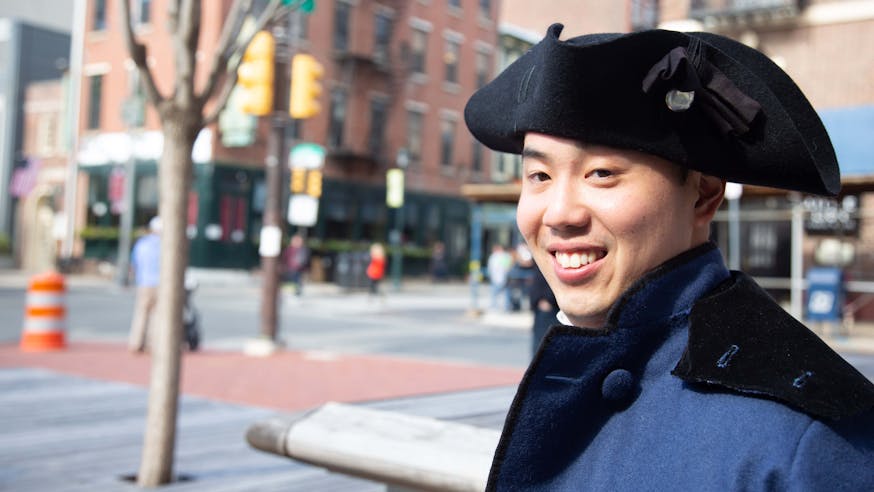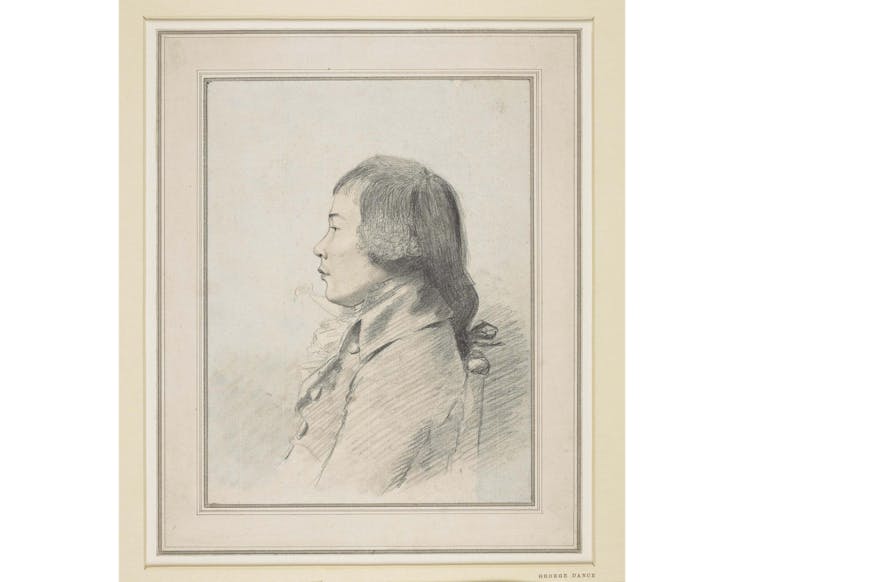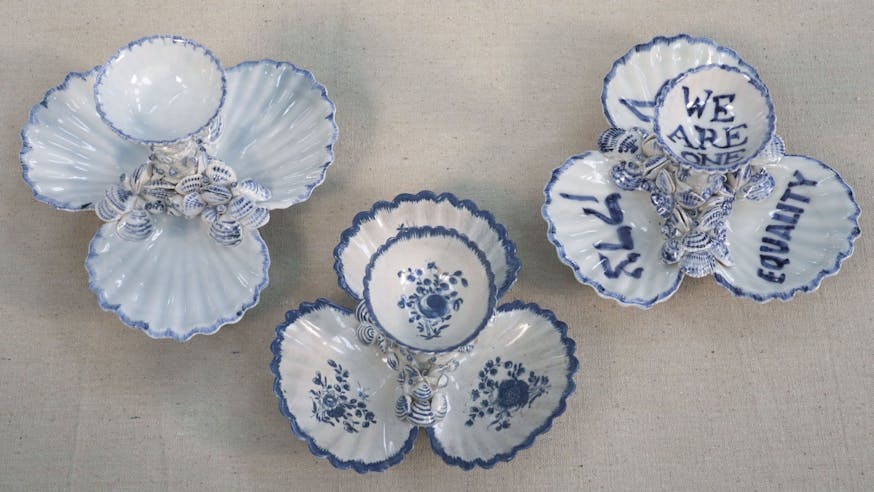Revolution Around the World
China and the American Revolution
May 2021
The Revolution Around the World series explores the impact of the American Revolution on the globe and the influence of people from other countries on the Revolutionary era.
What was happening around the world in 1776? When and why did different countries get involved in the Revolutionary War? What was the impact of the broader American Revolution on those countries?
Take a closer look as we examine the role China played in the American Revolution.
What was happening in China in 1776?
1776 began a decade-long period of “Pax Sinica” for China, a time of relative peace in East Asia led by the Qing Dynasty. The Qing Dynasty had ruled China for over 130 years by 1776, and the Qianlong Emperor was 40 years into his 61-year reign, which saw exploding population growth, expanding borders, and more money in the treasury than ever before. The Dynasty’s last major war was against the Konbaung Dynasty of Burma (Myanmar) and ended with the withdrawal of Chinese troops in 1770 after sustaining heavy losses and failing to conquer the country. Starting in 1771, the Dynasty fought a protracted and expensive war against the Jinchuan hill peoples that would end in the suppression and displacement of those tribes in 1776. The Qing Dynasty’s next war would not commence until 1786, this time against Taiwanese rebels. During the Qianlong Emperor’s time on the throne, a greater diversity of peoples became part of China with the incorporation of Uyghurs, Kazakhs, Kirghiz, Evenks, Mongols, and others. The year 1776 falls within an era known as the High Qing period because of the increase in China’s power and influence in the region throughout the time period.
When did China become involved in the American Revolution?
China’s involvement in the Revolution was one of goods and trade. Tea, porcelain, and silk were goods that were quite popular in the colonies and would be at the center of some colonial protest movements. China was the main global producer of all three. Tea, most famously, would be tossed into Boston Harbor in 1773. Silk and porcelain would be part of the non-importation strategy that colonists engaged in to boycott foreign goods. Porcelain was a product that people in British North America and all around the world had tried to recreate for decades. At this point in the 18th century, there had been some attempts and experimentation both in England and the Americas but no widespread success. The American China Manufactory in Philadelphia was founded in 1770 by Gousse Bonnin and George Anthony Morris but only operated for three years. It is believed they produced hard-paste porcelain based on technology originating in China. One such Philadelphia-made porcelain punch bowl was actually found on the site of the Museum during archaeological excavations, but with the manufactory’s short-lived presence in the city, there was apparently little substantial output. This meant that China remained the source of hard-paste porcelain for years to come. For silk, Americans and Europeans had understood necessary production techniques since the 17th century, but sericulture (the production of silk) was still a difficult process. When a woman from Connecticut was able to harvest six thousand balls of silk from a single mulberry tree during non-importation, she was celebrated in the newspaper. In each of these cases, however, European and American efforts to displace Chinese trade goods were only just beginning.

Which side did China choose, and why?
The Qing Dynasty in China did not involve itself in the Revolutionary War. The British Empire had established trade connections with the Qing over a century earlier in 1672, but the Qianlong Emperor had very little interest in deepening a relationship with those he saw (and described) as barbarians. The Emperor’s attitude toward other nations aligned with China’s view of its place in the world. The title of Celestial Empire was used by the Chinese, and later by Europeans and Americans, for the country. Another term was “Heavenly Dynasty,” or a dynasty mandated by Heaven to rule. This was not unlike the ideas expressed in European views of monarchs, like the “Sun King,” Louis XIV of France (1638-1715), and the British Monarchy’s phrase, “Deus ex Mon Droit” (God and my right).
The trade agreements with European powers kept the foreign nations far from the court of the Celestial Empire. Through China’s intricately bureaucratic governmental system, the British East India Company was dealt with through one specific merchant guild on the island of Canton, where the British merchants were restricted to conducting all their business. Goods in China were produced for all parts of the British Empire, but colonists in the Americas generally did not trade directly with the Chinese due to mercantilist laws and regulations imposed by England since the 17th century. It would not be until after the Revolutionary War, in 1784, that an American merchant ship would begin independent trade with China for the new United States.
Who were the key Chinese players in this story?
The key Chinese player in the Revolution was not a person but a commodity: tea. The financial needs of the British East India Company and the Empire were vast in the 1760s and 1770s due to the cost of the Seven Years’ War. In an effort to increase the profitability of the British East India Company, Parliament passed the Tea Act, authorizing merchants to bypass England and trade directly in the colonies, undercutting even the prices of smuggled tea and giving the East Indian Company (and its investors) a monopoly on the trade. This would lead to protests of the Act, culminating in the Boston Tea Party.
What was the impact of China's involvement?
The impact of the goods traded from China was an acceleration of the protest movements and escalation of tensions between the colonists and the British Empire. The economic needs of the British East India Company led to the passage of the Tea Act, undercutting the profits of local merchants in America, leading to the destruction of tea in Boston, the passage of the Coercive (Intolerable) Acts in 1774, closing the port of Boston, the formation of the First Continental Congress, and eventually war, in 1775. Almost as soon as the war ended, American merchants and investors began funding direct trading ventures with China, and the “China trade” remained one of the most lucrative global exchange networks for decades to come.
Dive Even Deeper
- More on porcelain: Take a closer look at a hard-paste porcelain punch bowl in our collection made in Jingdezhen, China around 1770. Then, read the New York Times's story on the Philadelphia-made porcelain punch bowl, referred to as the "Holy Grail of American ceramics" by Robert Hunter. Plus, watch internationally renowned ceramicist Michelle Erickson recreate a porcelain pickle stand made at Gousse Bonnin and George Anthony Morris's American China Manufactory in Philadelphia in the 1770s.
- Related Read the Revolution recommendations: Read an excerpt from Rebecca Yamin's book Archaeology at the Site of the Museum of the American Revolution for more on the artifacts — including the "Holy Grail" punch bowl — found during the archaeological excavation at the Museum site. Plus, read an excerpt exploring the tea trade and Americans's gradual shift towards coffee from Libby O'Connell's The American Plate.
- More on Asian Americans in the Revolutionary era: Historian Daniel Sieh joined us for a Meet the Revolution interview to discuss his work bringing Asian and Asian American history to the forefront, and he wrote an exploration into how the story of Charles Peters, an Asian man who served in the Continental Army, provides a fascinating window into the contributions made by Asian people in the American Revolution.
- In the Museum's galleries: Either on your next visit to the Museum or through our Virtual Museum Tour, pay close attention to China's influence within the gallery featuring the Boston Liberty Tree. Not only will you find examples of both Chinese- and American-made hard-paste porcelain on display, you can also learn more about the Boston Tea Party and the economic impacts of the tea trade.
Learn More

Meet the Revolution: Daniel Sieh

Looking Through the Silk Screen: Asian People in the American Revolution

